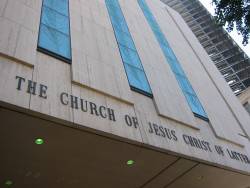Gotta give the ol’ KJV credit. It tripped up the leaders of the LDS Church, way back when. Of course, today, modern Mormons might not care too much about how their original leaders were so ignorant of the Bible that they could make truly amazing mistakes, but anyone who seriously thinks these men were prophets of God in any meaningfully true fashion might wish to consider the facts. I refer to how the KJV exposed Joseph Smith, Jr., and Joseph F. Smith regarding the identity of Elijah. Here’s the “fast-start” version.
Modern translations follow a translational practice of rendering the names of Old Testament prophets and personalities by their Hebrew names even when they appear in the New Testament in their Greek versions. Hence, while you might see “Esias” twenty-one times in the New Testament of the KJV, that’s actually Isaiah. “Esias” is the Greek version of “Isaiah.” Modern translations simply render it “Isaiah” and do away with all the confusion.
One of the names that appears in two different forms in the KJV is that of Elijah, which appears in the New Testament as Elias. Now, as difficult as it may be to believe, early Mormon leaders, men who identified themselves as “prophets” and “apostles,” confused this simple translational issue and came up with two different “prophets,” one Elijah, and one Elias. Check out these references:
THE DOCTRINE AND COVENANTS
SECTION 110
Visions manifested to Joseph Smith the Prophet and Oliver Cowdery in the temple at Kirtland, Ohio, April 3, 1836. HC 2: 435-436. The occasion was that of a Sabbath day meeting. The Prophet prefaces his record of the manifestations with these words: “In the afternoon, I assisted the other Presidents in distributing the Lord’s Supper to the Church, receiving it from the Twelve, whose privilege it was to officiate at the sacred desk this day. After having performed this service to my brethren, I retired to the pulpit, the veils being dropped, and bowed myself, with Oliver Cowdery, in solemn and silent prayer. After rising from prayer, the following vision was opened to both of us.”
1-10, The Lord Jehovah appears in glory and accepts the Kirtland Temple as his house; 11-12, Moses and Elias each appear and commit their keys and dispensations; 13-16, Elijah returns and commits the keys of his dispensation as promised by Malachi.
11 After this vision closed, the heavens were again opened unto us; and Moses appeared before us, and committed unto us the keys of the egathering of Israel from the four parts of the earth, and the leading of the ten tribes from the land of the north.
12 After this, Elias appeared, and committed the bdispensation of the gospel of Abraham, saying that in us and our seed all generations after us should be eblessed.
13 After this vision had closed, another great and glorious avision burst upon us; for Elijah the prophet, who was taken to heaven without tasting death, stood before us, and said:
14 Behold, the time has fully come, which was spoken of by the mouth of Malachi-testifying that he [Elijah] should be sent, before the great and dreadful day of the Lord come-
SECTION 138
A vision, given to President Joseph F. Smith in Salt Lake City, Utah, on October 3, 1918. In his opening address at the eighty-ninth Semiannual General Conference of the Church, on October 4, 1918, President Smith declared that he had received several divine communications during the previous months. One of these, concerning the Savior’s visit to the spirits of the dead while his body was in the tomb, he had received the previous day. It was written immediately following the close of the conference; on October 31, 1918, it was submitted to the counselors in the First Presidency, the Council of the Twelve, and the Patriarch, and it was unanimously accepted by them.
45 Elias, who was with Moses on the Mount of Transfiguration;
46 And Malachi, the prophet who testified of the coming of Elijah-of whom also Moroni spake to the Prophet Joseph Smith, declaring that he should come before the ushering in of the great and dreadful cday of the Lord-were also there.
47 The Prophet Elijah was to plant in the hearts of the children the promises made to their fathers,
48 Foreshadowing the great work to be done in the temples of the Lord in the dispensation of the fulness of times, for the redemption of the dead, and the sealing of the children to their parents, lest the whole earth be smitten with a curse and utterly wasted at his coming.
49 All these and many more, even the aprophets who dwelt among the Nephites and testified of the coming of the Son of God, mingled in the vast assembly and waited for their deliverance,
In both D&C 110 and 138 we find both Elias and Elijah making appearances, a pretty neat trick when you consider they are two different forms of the same name, and hence the same person. Now, should you find it difficult to believe that someone could know so little about the Bible and be an alleged “prophet,” remember that LeGrand Richards, another LDS apostle, liked to cite Isaiah 29:4 as proof of the inspiration of the Book of Mormon:
And thou shalt be brought down, [and] shalt speak out of the ground, and thy speech shall be low out of the dust, and thy voice shall be, as of one that hath a familiar spirit, out of the ground, and thy speech shall whisper out of the dust. (KJV)
Of course, a “familiar spirit” is actually a demonic spirit, but “apostle” Richards did not know this.



